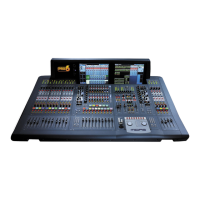177
PRO6 Live Audio System
Owner’s Manual
Chapter 20: Scenes And Shows
(Automation)
This chapter shows you how to use scenes and shows, which are part of the PRO6’s
automation.
About automation
Automation is predominantly a GUI-only function that allows complex editing of scenes
and the creation of show files via the GUI menu. The control surface provides limited
control via the automation section, which facilitates fast store/recall operation during
show time and rehearsals.
The automation system of the PRO6 can store and recall up to 1000 scenes, each one
being a snapshot of the control centre’s settings at the instant the scene was created.
By recalling scenes, users can — with certain exceptions — restore the control centre to
the state that existed at that time the scenes were stored. This makes it ideal for
multi-act tours by providing quick and accurate access of settings for the band with a
minimum of sound check time, as well as for theatre productions, where each act
requires reconfiguration of audio I/O.
All of the scenes for a show are contained within a show file. Show files are stored in
the PRO6, so that they can be loaded when required, and they can also be transferred
to/from external USB storage devices.
Events provide an additional scene control by which you can use the MIDI, GPIO and
‘internal’ functions to trigger events on internal and external devices from within the
show file.
For theatre applications, channel settings can be recalled (across all scenes) from the
user library (see Chapter 24 "User Libraries (Presets)" on page 213) so that one generic
show can cope with different performers on a night-by-night bases, which is common in
theatres.
You can copy certain parameters through scenes by using the Show Editor screen.
For more information on the Show Editor screen and for details on how to use it for
copying and pasting throughout scenes, see “Show editor” on page 97. For details of
the parameters that can be copied through the scenes, see Appendix P "Parameters
Copied Through Scenes" on page 543.
Throughout this chapter, wherever scenes are mentioned this also applies to point
scenes, unless otherwise stated.

